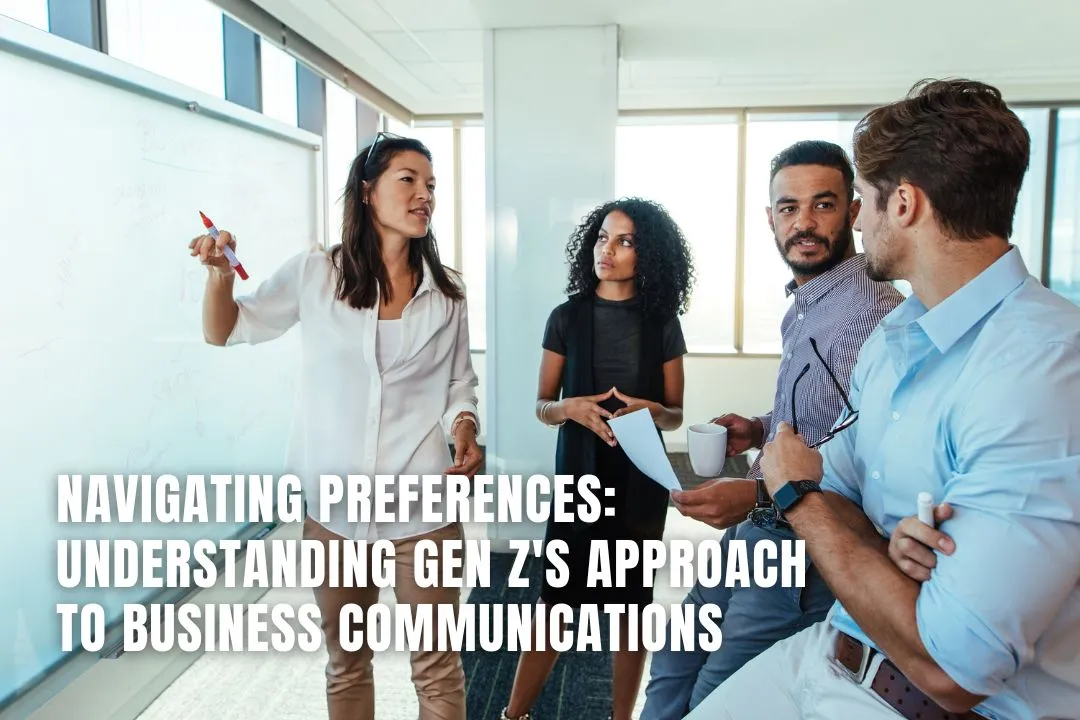Navigating Preferences: Understanding Gen Z's Approach to Business Communications
October 2, 2024

Understanding how Gen Z communicates in the workplace is crucial for businesses today. This generation, born between 1997 and 2012, has unique preferences shaped by technology and social media. By recognizing their values and communication styles, companies can foster a better work environment that benefits everyone.
Key Takeaways on Gen Z Business Communications
- Authenticity Matters: Gen Z values genuine interactions in the workplace, leading to increased trust, employee satisfaction, and better collaboration. Companies should prioritize authentic communication to foster a positive work environment.
- Preferred Communication Channels: Gen Z favors texting and instant messaging platforms like Slack over traditional emails. Visual communication, including images and videos, is also essential for engaging this generation effectively.
- Short Attention Spans: With an average attention span of about 8 seconds, concise messaging is critical. Techniques such as bullet points, limited text, and incorporating visuals can help capture their interest.
- Bridging Generational Gaps: Understanding and respecting different communication styles across generations can enhance teamwork. Strategies like fostering empathy, mentorship programs, and inclusive language can facilitate better communication.
- The Role of Technology: As digital natives, Gen Z is comfortable using various tech platforms for communication. Businesses must leverage technology while balancing it with personal connections to enhance engagement.
- Personalization is Key: Tailored messages that resonate with individual preferences are crucial for effective communication with Gen Z. One-on-one interactions are particularly valued, emphasizing the need for direct engagement.
- Challenges in Multigenerational Workplaces: Communication barriers, stereotypes, and technology gaps can hinder collaboration. Organizations can overcome these challenges through empathy, mentorship, and promoting mutual respect.
Register Your LLC
Company Registration
START NOWThe Importance of Authenticity in Gen Z Business Communications
Valuing Genuine Interactions
Gen Z places a high value on authenticity in their communications. They prefer real, honest interactions over formalities. This generation believes that genuine connections lead to better relationships in the workplace. They want to feel that their voices are heard and respected.
Impact on Workplace Culture
The presence of authenticity can significantly shape workplace culture. When companies foster an environment that encourages open communication, it leads to:
- Increased trust among team members
- Higher employee satisfaction
- Better collaboration across different generations
Challenges with Forced Authenticity
However, there are challenges. Many Gen Z individuals can sense when authenticity is forced. This can lead to feelings of distrust and disengagement. Companies must strive to create a culture that genuinely values authenticity rather than just promoting it as a buzzword.
Authenticity is not just a value; it’s a way of being. When companies allow Gen Z to be themselves, they create a more inclusive and productive environment.
In summary, understanding and embracing authenticity is crucial for effective communication with Gen Z. It not only enhances interactions but also strengthens workplace culture, making it essential for businesses to adapt to these preferences.
Preferred Communication Channels for Gen Z
Texting Over Emails
Gen Z prefers texting over emails for quick communication. Instant messaging platforms like Slack and Microsoft Teams are their go-to choices. In fact, a survey found that nearly 75% of Gen Zers would rather text than talk on the phone. This preference highlights their desire for immediate and concise interactions.
The Role of Social Media
Social media plays a significant role in how Gen Z communicates. They often use platforms like Instagram, TikTok, and Snapchat to express themselves visually. This generation enjoys sharing information through images and videos, making communication more engaging and relatable.
Visual Communication Preferences
Gen Z favors visual communication over lengthy text. They respond better to images, emojis, and short videos. This preference is driven by their shorter attention spans, which average around 8 seconds. To effectively reach this audience, businesses should focus on creating content that is visually appealing and easy to digest.
In a world where attention spans are fleeting, visuals are key to capturing Gen Z's interest.
Adapting to Gen Z's Short Attention Span
Concise Messaging Techniques
To effectively communicate with Gen Z, messages must be short and to the point. Here are some techniques:
- Use bullet points for clarity.
- Limit text to a few sentences.
- Incorporate visuals to enhance understanding.
Utilizing Snack Media
Gen Z thrives on quick, engaging content. Snack media includes:
- Short videos (like TikToks)
- Memes and GIFs
- Infographics that summarize information
Balancing Multitasking and Focus
Gen Z is known for multitasking, often engaging with multiple screens. To adapt:
- Encourage short breaks to maintain focus.
- Use interactive tools that allow for engagement without overwhelming them.
- Foster an environment that values quick feedback to keep them engaged.
Understanding Gen Z's communication style is crucial. They prefer genuine interactions and quick responses, making it essential to adapt our methods accordingly.
In summary, adapting to Gen Z's short attention span requires a focus on concise messaging, snack media, and a balance between multitasking and focus. Engaging them effectively means meeting them where they are.
Bridging the Generational Communication Gap
Understanding Different Generational Styles
To effectively communicate across generations, it’s important to recognize that each group has its own style. Understanding these differences can lead to better teamwork. Here are some key points:
- Baby Boomers prefer face-to-face interactions and formal communication.
- Generation X values directness and efficiency, often using emails.
- Millennials and Gen Z lean towards digital communication, favoring texts and social media.
Effective Cross-Generational Strategies
To bridge the gap, consider these strategies:
- Foster Empathy: Encourage team members to share their experiences and perspectives.
- Highlight Common Goals: Focus on shared objectives that unite all generations.
- Mentorship Programs: Pair younger employees with seasoned workers to promote learning and respect.
Building Empathy and Flexibility
Creating a culture of understanding is essential. Here are some actions to take:
- Open Communication: Create a safe space for everyone to express their preferences.
- Inclusive Language: Use clear language that everyone can understand, avoiding jargon.
- Collaborative Projects: Encourage teamwork across generations to share ideas and skills.
By embracing these strategies, organizations can create a more inclusive environment where all generations feel valued and understood.
In summary, bridging the generational communication gap requires effort and understanding. By recognizing different styles and fostering collaboration, businesses can enhance their workplace culture and improve communication.
The Role of Technology in Gen Z Communication

Digital Natives and Tech Savviness
Gen Z is the first generation to grow up with technology all around them. They are digital natives, meaning they are very comfortable using various devices and platforms. This comfort allows them to switch between tasks quickly and efficiently. Here are some key points about their tech savviness:
- They often use multiple screens at once.
- They prefer instant messaging over traditional emails.
- They communicate using emojis and visual content.
Impact of Global Connectivity
With the world at their fingertips, Gen Z is more connected than ever. This global connectivity influences their communication style in several ways:
- They value diverse perspectives and inclusivity.
- They are sensitive to language that may be considered exclusive or offensive.
- They often engage with content from different cultures, enhancing their understanding of global issues.
Leveraging Online Platforms for Inclusivity
Gen Z uses online platforms to create a more inclusive environment. They appreciate when businesses and organizations:
- Personalize their messages to resonate with individual preferences.
- Use visual communication to convey complex ideas simply.
- Balance technology with personal connections, ensuring that interactions feel genuine.
In today's fast-paced world, balancing technology and personal connections is crucial for effective communication. While tech enhances efficiency, it should complement rather than replace human interactions.
Overall, technology plays a significant role in shaping how Gen Z communicates, making it essential for businesses to adapt to their preferences.
Personalization in Gen Z Business Communications

Importance of Tailored Messages
Gen Z values personalized communication that speaks directly to them. They appreciate when messages are tailored to their interests and needs. This can include:
- Using their name in messages.
- Referring to past interactions or preferences.
- Offering relevant content based on their behavior.
One-on-One Communication
While Gen Z enjoys digital interactions, they also find one-on-one communication to be the most effective. In fact, 39% of Gen Z prefers personal conversations over group chats or mass emails. This highlights the need for businesses to:
- Create opportunities for direct engagement.
- Use platforms that facilitate personal interactions, like messaging apps.
- Encourage feedback to make conversations more meaningful.
Balancing Personal and Digital Interactions
Finding the right mix of personal and digital communication is crucial. Gen Z thrives on authentic connections but also values efficiency. Here are some tips:
- Use emojis and informal language to make messages feel friendly.
- Incorporate visuals to enhance understanding and engagement.
- Be concise; long messages can lose their attention quickly.
Personalization is not just a trend; it’s a necessity for engaging Gen Z effectively. By understanding their preferences, businesses can create a more inviting and effective communication environment.
By focusing on these elements, businesses can enhance their communication strategies and better connect with Gen Z, ultimately leading to improved relationships and outcomes.
Challenges and Solutions in Multigenerational Workplaces
In today’s workplaces, generational differences can create challenges in communication. Understanding these challenges is key to fostering a productive environment.
Common Communication Barriers
- Misunderstandings: Different generations often have unique ways of expressing themselves, which can lead to confusion.
- Stereotypes: Preconceived notions about age groups can hinder collaboration and respect.
- Technology Gaps: Not everyone is comfortable with the latest tools, leading to frustration.
Strategies for Effective Collaboration
- Foster Empathy: Encourage team members to share their experiences and perspectives. This can help build understanding and respect.
- Mentorship Programs: Pair younger employees with older ones to share knowledge and skills, breaking down stereotypes.
- Inclusive Language: Use clear and simple language that everyone can understand, avoiding jargon that may alienate some team members.
Promoting Mutual Respect and Understanding
To create a harmonious workplace, it’s essential to:
- Encourage Open Dialogue: Create a safe space for discussions about communication preferences.
- Balance Communication Styles: Use a mix of formal and informal communication methods to cater to different preferences.
- Continuous Learning: Promote a culture where all employees are encouraged to learn from each other, regardless of age.
By addressing these challenges, organizations can create a more inclusive and effective workplace for everyone.
Conclusion
In summary, understanding how Gen Z communicates is essential for any workplace. This generation values being real and honest in their interactions. They prefer quick messages over long emails and often use emojis to express themselves. As they become a bigger part of the workforce, their unique style is changing how we all communicate. It’s important for older generations to adapt and be open to these changes. By listening and being patient, everyone can work together better. Embracing these differences can lead to a more positive and productive work environment.
Frequently Asked Questions
What does Gen Z value in business communication?
Gen Z really cares about being real and genuine when they talk. They want interactions to feel honest and not forced.
Which communication methods do Gen Z prefer?
They usually prefer texting over emails and enjoy using social media for quick chats.
How can businesses keep Gen Z engaged?
To keep Gen Z interested, messages should be short and to the point. Using visuals and videos can also help.
What challenges do different generations face in communication?
Older generations might not understand the relaxed style of communication that Gen Z prefers, leading to confusion.
How important is technology for Gen Z communication?
Technology is super important for Gen Z. They grew up with it and use it to connect with others in their work.
Why is personalization key for reaching Gen Z?
Personalized messages grab Gen Z's attention. They want to feel like messages are meant just for them.

